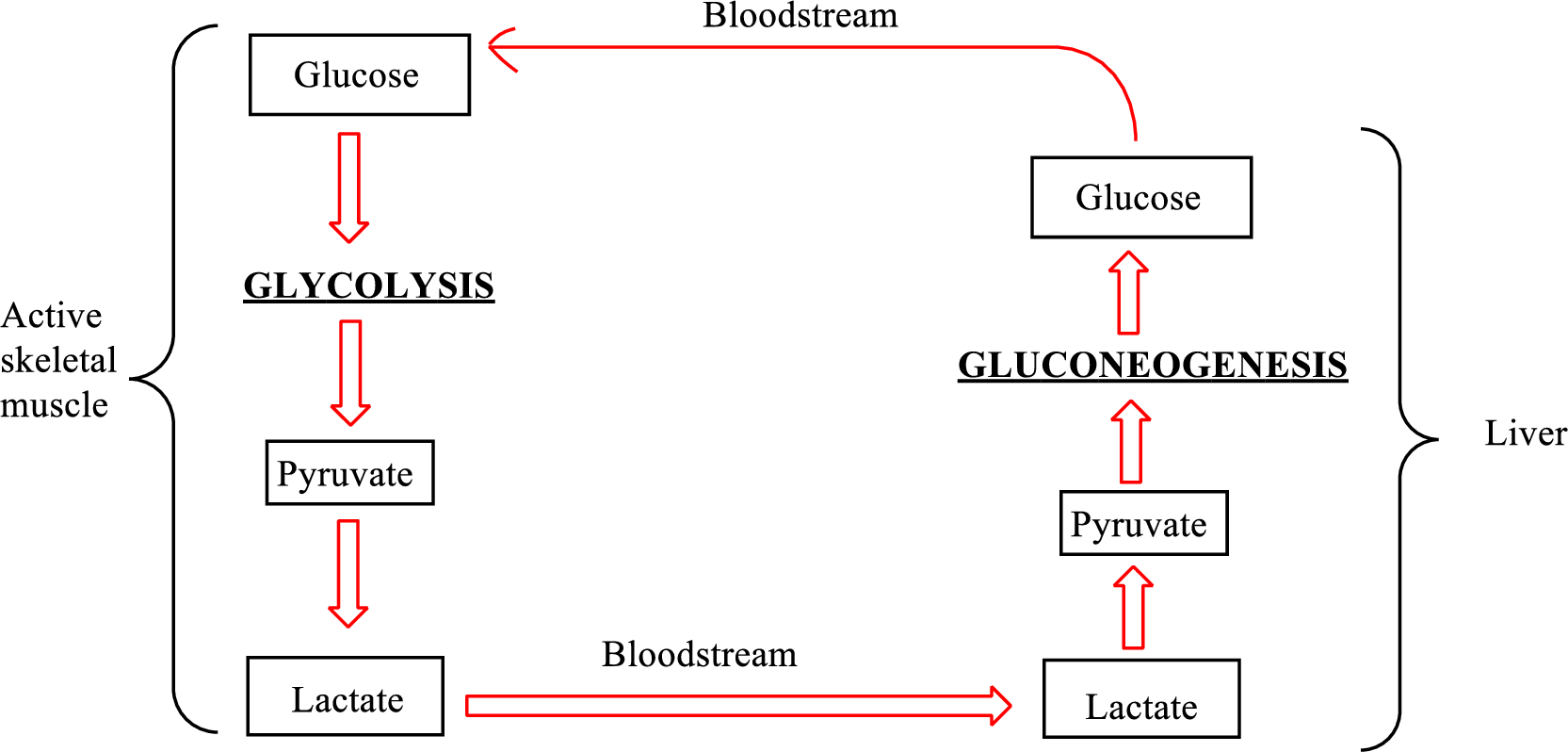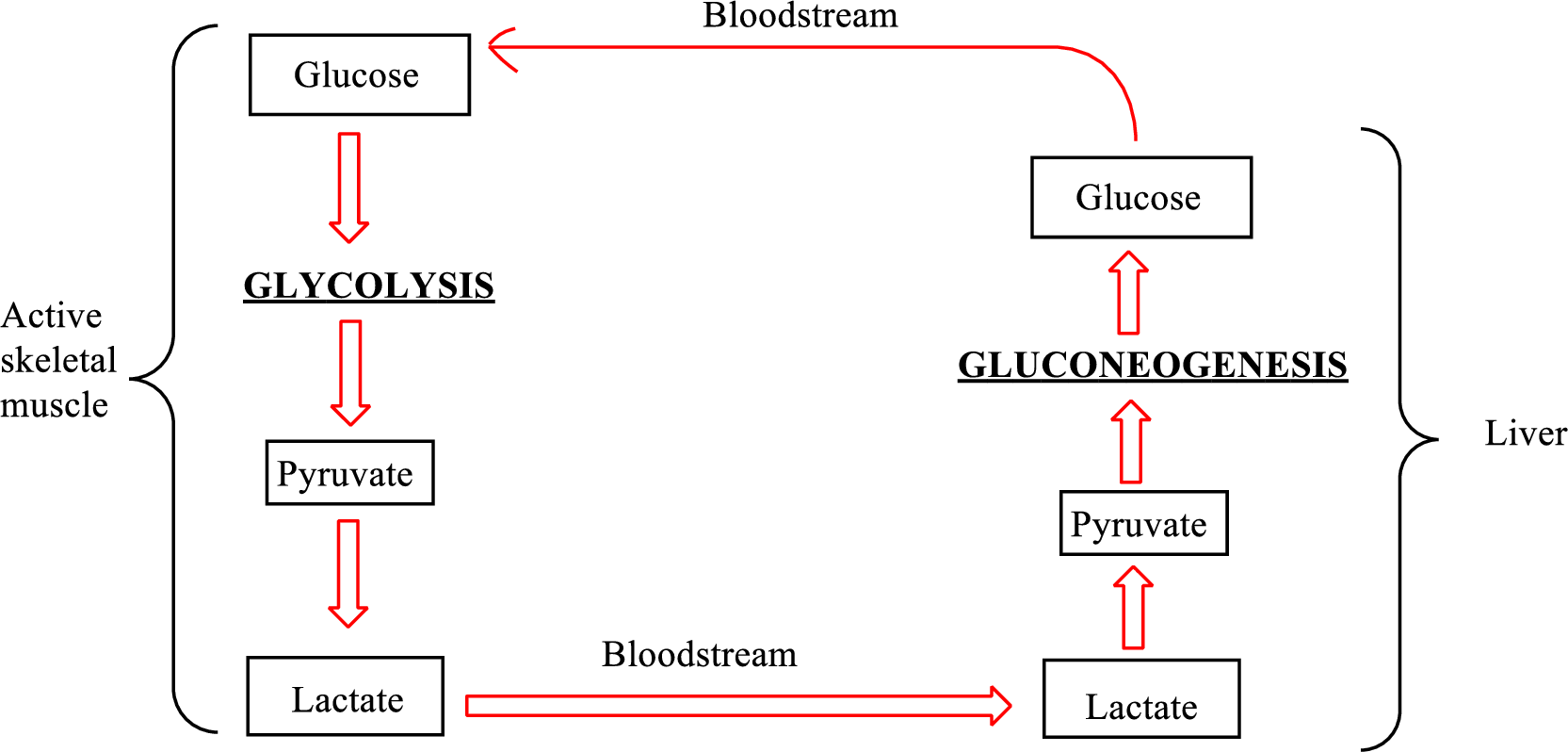
Concept explainers
(a)
Interpretation: To indicate whether pyruvate is involved in (1) the pentose phosphate pathway, (2) the Cori cycle, (3) glycolysis, or (4) lactate fermentation.
Concept introduction: The pentose phosphate pathway is defined as the metabolic pathway in which NADPH,
Glucose is converted to pyruvate by glycolysis metabolic pathway; pyruvate is further converted to lactate in the skeletal muscle cells by anaerobic reactions. The lactate is diffused into the bloodstream, by which it is transported to the liver. Lactate is reconverted to pyruvate. Gluconeogenesis metabolic pathway uses this pyruvate to synthesize glucose in the liver cells. Glucose is diffused into the bloodstream and is transported back to the active skeletal muscle cells. This cycle is known as the Cori cycle.
Glycolysis is the metabolic pathway that breaks down a glucose molecule and converts it into two pyruvate molecules along with the production of two ATP molecules and NADH coenzymes.
Fermentation is defined as the biochemical anaerobic process by which NADH is oxidized to
Pyruvate
(a)
Answer to Problem 24.106EP
Pyruvate is associated with (2) the Cori cycle, (3) glycolysis, and (4) the lactate fermentation.
Explanation of Solution
An overview of the Cori cycle is as follows:

Lactate is converted to pyruvate in the liver and pyruvate is converted to lactate in the active skeletal muscle cells. Therefore, pyruvate is associated with the Cori cycle.
The net overall equation for the glycolysis process is as follows:
Therefore, pyruvate is the final product of glycolysis metabolic pathway.
Pyruvate is converted to lactate under oxygen-poor conditions by lactate dehydrogenase enzymes in the human body. This anaerobic reduction of pyruvate to form lactate by enzymes is called lactate fermentation. The
Therefore, pyruvate is associated with lactate fermentation.
(b)
Interpretation: To indicate whether
Concept introduction: The pentose phosphate pathway is defined as the metabolic pathway in which NADPH,
Glucose is converted to pyruvate by glycolysis metabolic pathway; pyruvate is further converted to lactate in the skeletal muscle cells by anaerobic reactions. The lactate is diffused into the bloodstream, by which it is transported to the liver. Lactate is reconverted to pyruvate. Gluconeogenesis metabolic pathway uses this pyruvate to synthesize glucose in the liver cells. Glucose is diffused into the bloodstream and is transported back to the active skeletal muscle cells. This cycle is known as the Cori cycle.
Glycolysis is the metabolic pathway that breaks down a glucose molecule and converts it into two pyruvate molecules along with the production of two ATP molecules and NADH coenzymes.
Pyruvate is converted to lactate under oxygen-poor conditions by lactate dehydrogenase enzymes in the human body. This anaerobic reduction of pyruvate to form lactate by enzymes is called lactate fermentation.
Nicotinamide adenine dinucleotide phosphate is associated with the
(b)
Answer to Problem 24.106EP
Explanation of Solution
The overall net equation for the pentose phosphate pathway is as follows:
Hence,
(c)
Interpretation: To indicate whether glucose is involved in (1) the pentose phosphate pathway, (2) the Cori cycle, (3) glycolysis, or (4) lactate fermentation.
Concept introduction: The pentose phosphate pathway is defined as the metabolic pathway in which NADPH,
Glucose is converted to pyruvate by glycolysis metabolic pathway; pyruvate is further converted to lactate in the skeletal muscle cells by anaerobic reactions. The lactate is diffused into the bloodstream, by which it is transported to the liver. Lactate is reconverted to pyruvate. Gluconeogenesis metabolic pathway uses this pyruvate to synthesize glucose in the liver cells. Glucose is diffused into the bloodstream and is transported back to the active skeletal muscle cells. This cycle is known as the Cori cycle.
Glycolysis is the metabolic pathway that breaks down a glucose molecule and converts it into two pyruvate molecules along with the production of two ATP molecules and NADH coenzymes.
Pyruvate is converted to lactate under oxygen-poor conditions by lactate dehydrogenase enzymes in the human body. This anaerobic reduction of pyruvate to form lactate by enzymes is called lactate fermentation.
(c)
Answer to Problem 24.106EP
Glucose is associated with (1) the pentose phosphate pathway, (2) the Cori cycle, and (3) glycolysis.
Explanation of Solution
The overall net equation for the pentose phosphate pathway is as follows:
Glucose is present in the form of
An overview of the Cori cycle is as follows:

The net overall equation for the glycolysis process is as follows:
Glucose is encountered as a reactant in is the glycolysis metabolic pathway. Therefore, glucose is involved in the pentose phosphate pathway, the Cori cycle, and (3) glycolysis.
(d)
Interpretation: To indicate whether
Concept introduction: The pentose phosphate pathway is defined as the metabolic pathway in which NADPH,
Glucose is converted to pyruvate by glycolysis metabolic pathway; pyruvate is further converted to lactate in the skeletal muscle cells by anaerobic reactions. The lactate is diffused into the bloodstream, by which it is transported to the liver. Lactate is reconverted to pyruvate. Gluconeogenesis metabolic pathway uses this pyruvate to synthesize glucose in the liver cells. Glucose is diffused into the bloodstream and is transported back to the active skeletal muscle cells. This cycle is known as the Cori cycle.
Glycolysis is the metabolic pathway that breaks down a glucose molecule and converts it into two pyruvate molecules along with the production of two ATP molecules and NADH coenzymes.
Pyruvate is converted to lactate under oxygen-poor conditions by lactate dehydrogenase enzymes in the human body. This anaerobic reduction of pyruvate to form lactate by enzymes is called lactate fermentation.
(d)
Answer to Problem 24.106EP
Explanation of Solution
The overall net equation for the pentose phosphate pathway is as follows:
An overview of the glycolysis metabolic pathway is as follows:

Isomerization is the second step in the glycolysis process.
Want to see more full solutions like this?
Chapter 24 Solutions
EBK GENERAL, ORGANIC, AND BIOLOGICAL CH
- The rate limiting and committed step of the pentose phosphate pathway is catalyzed by which of the following enzymes? A. Glucose-6-phosphate dehydrogenase B. Hexokinase C. 6-Phosphogluconate dehydrogenase D. Transketolasearrow_forwardIf 14CO2 (radioactive carbon) were incorporated into the TCA cycle via the Pyruvate Carboxylase reaction which of the following molecules would contain radioactive carbon? a. Oxaloacetate b. Citric Acid c. Isocitrate d. Alpha-ketoglutarate e. Succinyl-CoA f .Succinate g. Fumarate h. Malatearrow_forwardGlyceraldehyde 3-phosphate dehydrogenase is used to do which of the following steps of glycolysis Select one: a. 1,3 Bisphosphoglycerate is converted to 3-phosphoglycerate b. Phosphoenolpyruvate is converted to pyruvate c. 2-phosphoglycerate is converted to Phosphoenolpyruvate d. Glyceraldehyde-3-phosphate is converted to 1,3 Bisphosphoglycerate e. Fructose-6-phosphate is converted to Fructose-1,6,bisphosphate f. Dihydroxyacetone (Glycerone Phosphate) is converted to Glyceraldehyde-3-phosphate g. Fructose-1,6 Bisphosphate is converted to Dihydroxyacetone and Glyceraldehyde-3-phosphate h. Glucose-6-phosphate is converted to Fructose-6-phosphate i. 3-phosphoglycerate is converted 2-phosphoglycerate j. Glucose is converted to Glucose-6-phosphatearrow_forward
- Which of the following enzymes is found in gluconeogenesis but not in glycolysis? a. phosphohexose isomerase b. hexokinase c. fructose 1,6-bisphosphatase d. phosphoglycerate kinasearrow_forwardFive coenzymes are required by a-ketoglutarate dehydrogenase, the enzyme in the citric acid cycle that converts a-ketoglutarate to succinyl-CoA.a. Identify the coenzymes.b. Propose a mechanism for the reaction.arrow_forwardWhich of the following enzymes possesses a catalytic mechanism extremely similar to that of the Pyruvate Dehydrogenase Complex? A. the isocitrate dehydrogenase B. the succinate dehydrogenase C. the alpha-ketoglutarate dehydrogenase D. the malate dehydrogenasearrow_forward
- For each of the following conditions, state whether this condition would be occurring during gluconeogenesis, glycolysis, or both in liver cells. a. Transporting malate from the cytosol into the mitochondria. _____________ b. Transporting pyruvate from the cytosol into the mitochondria. _____________ c. We would have an increased (or increasing) concentration of F26BP. __________ d. Increased concentration of F6P.__________ e. Hexokinase IV (or glucokinase) is found in the nucleus of the cell. __________ f. The enzyme that synthesizes/breaks down F26BP is phosphorylated. __________ g. Elevated levels of glucagon in the blood. ____________arrow_forwardWhich of the following is the ninth step of glycolysis? Select one: a. Fructose-1,6 Bisphosphate is converted to Dihydroxyacetone and Glyceraldehyde-3-phosphate b. 1,3 Bisphosphoglycerate is converted to 3-phosphoglycerate c. Phosphoenolpyruvate is converted to pyruvate d. Dihydroxyacetone (Glycerone Phosphate) is converted to Glyceraldehyde-3-phosphate e. Fructose-6-phosphate is converted to Fructose-1,6,bisphosphate f. 3-phosphoglycerate is converted 2-phosphoglycerate g. Glyceraldehyde-3-phosphate is converted to 1,3 Bisphosphoglycerate h. Glucose-6-phosphate is converted to Fructose-6-phosphate i. 2-phosphoglycerate is converted to Phosphoenolpyruvate j. Glucose is converted to Glucose-6-phosphatearrow_forward2a) Which of the following statements about pyruvate oxidation IS TRUE? a. NADH is oxidized in the process b. Four carbon dioxide molecules are released in the process c. The process takes place in the cytoplasm d. There is substrate level phosphorylation during the process e. Two pyruvate molecules are oxidized to two acetyl Co-A molecules. 2b) When there is sufficient oxygen, _____ ATP molecules can be made (theoretically) by cellular respiration. However, when oxygen is lacking, only _____ ATP molecules are made a. 32,2 b. 36,2 c. 30,4 d. 36,6 e. 46,2 2c) In the electron transport chain of cellular respiration: a. oxygen has the weakest pull on electrons b. NADH and FADH2 transfer phosphates in the inner mitochondrial membrane c. the energy that is released moves electrons from the matrix to the intermembrane space d. electrons move from protein to protein due to increasing electronegativity e. water oxidizes the last component of the chain. 2d) Which of the…arrow_forward
- The glycolysis reaction map indicates that is also a substrate for the pentose phosphate pathway (PPP), while product of the PPP and an intermediate for glycolysis. A. \beta-D-Glucose-6-phosphate; glyceraldehyde-3-phosphate B. \alpha - D- Glucose-6-phosphate; glyceraldehyde-3- phosphate C. \alpha-D-Glucose-6-phosphate; glycerate D. \alpha-D-Glucose-6-phosphate; glycerate-3-phosphate is aarrow_forwardWhich of the following reactions is reversible and irreversible? Why? a. Pyruvate + β-hydroxybutyrate → lactate + acetoacetate b. Malate + pyruvate → oxaloacetate + lactate c. Acetaldehyde + succinate → ethanol + fumarate d. Pyruvate + NADH + H+ → lactate NAD+ e. Acetoacetate + NADH + H+ → β-hydroxybutyrate + NAD+ f. Malate + NAD+ → oxaloacetate + NADH + H+arrow_forwardDetermine the number of carbon atoms present and the the total number of phosphate groups present in each of these following intermediates of glycolysis: a. Glucose 6-phosphate b. Fructose 1,6-phosphatearrow_forward
 Human Anatomy & Physiology (11th Edition)BiologyISBN:9780134580999Author:Elaine N. Marieb, Katja N. HoehnPublisher:PEARSON
Human Anatomy & Physiology (11th Edition)BiologyISBN:9780134580999Author:Elaine N. Marieb, Katja N. HoehnPublisher:PEARSON Biology 2eBiologyISBN:9781947172517Author:Matthew Douglas, Jung Choi, Mary Ann ClarkPublisher:OpenStax
Biology 2eBiologyISBN:9781947172517Author:Matthew Douglas, Jung Choi, Mary Ann ClarkPublisher:OpenStax Anatomy & PhysiologyBiologyISBN:9781259398629Author:McKinley, Michael P., O'loughlin, Valerie Dean, Bidle, Theresa StouterPublisher:Mcgraw Hill Education,
Anatomy & PhysiologyBiologyISBN:9781259398629Author:McKinley, Michael P., O'loughlin, Valerie Dean, Bidle, Theresa StouterPublisher:Mcgraw Hill Education, Molecular Biology of the Cell (Sixth Edition)BiologyISBN:9780815344322Author:Bruce Alberts, Alexander D. Johnson, Julian Lewis, David Morgan, Martin Raff, Keith Roberts, Peter WalterPublisher:W. W. Norton & Company
Molecular Biology of the Cell (Sixth Edition)BiologyISBN:9780815344322Author:Bruce Alberts, Alexander D. Johnson, Julian Lewis, David Morgan, Martin Raff, Keith Roberts, Peter WalterPublisher:W. W. Norton & Company Laboratory Manual For Human Anatomy & PhysiologyBiologyISBN:9781260159363Author:Martin, Terry R., Prentice-craver, CynthiaPublisher:McGraw-Hill Publishing Co.
Laboratory Manual For Human Anatomy & PhysiologyBiologyISBN:9781260159363Author:Martin, Terry R., Prentice-craver, CynthiaPublisher:McGraw-Hill Publishing Co. Inquiry Into Life (16th Edition)BiologyISBN:9781260231700Author:Sylvia S. Mader, Michael WindelspechtPublisher:McGraw Hill Education
Inquiry Into Life (16th Edition)BiologyISBN:9781260231700Author:Sylvia S. Mader, Michael WindelspechtPublisher:McGraw Hill Education





